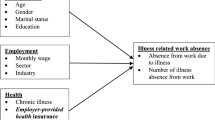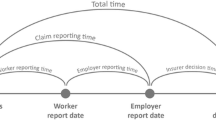Abstract
Despite voluminous studies on compensating wage differentials for job-related fatal or non-fatal injuries, there remain few published studies confirming the existence of compensating wage differentials for job-related illness. This study utilizes a recently completed UK employer-employee survey to look at this specific issue. I find there is strong evidence of wage compensation for job-related illness risk for both male and female employees in the UK. The estimated wage compensation for one job-related illness episode per year ranges from 27% to 140% of annual earnings depending on gender and estimation approaches.
Similar content being viewed by others
Notes
See Viscusi and Aldy (2003) for a detailed survey.
See Health and Safety Statistics 2004/05 published by the Health and Safety Commission in the UK.
Since the average establishment size is 285 in WERS, the survey actually covers well over half million laborforce in the UK.
However, the estimated differences in CWD for union vs. non-union and male manual vs. male non-manual employees do appear to be sizeable in many cases even though none of these differences are statistically significant.
The author has asked the person in charge of WERS about how accurate these management answers are, and was told that in most cases these answers were based on the memories of the managers. Since job-related illnesses and injuries are relatively rare events they should be quite accurate, especially for those small establishments.
This may be due to the fact that the most frequently reported job-related illness cases in the UK are in the categories of musculoskeletal disorder, stress, depression or anxiety (accounting for more than 75% of the cases). See Health and Safety Statistics 2004/05 published by the Health and Safety Commission in the UK.
The wage equation should be estimated for male and female workers separately due to the argument that the male wage structure is likely to be different from that of the female’s. Furthermore, Joni Hersch (1998) has also found that the male workers’ CWD for job risks can be quite different from the female workers’ in the US.
For more details about this bias, see Moulton (1990).
See Purdon and Pickering (2001) for the details of the weights in WERS.
Sandy and Elliott (2005) show that their LFS based measure of illness risk is related to firm size and their results are more significant for firms with 1-25 employees.
However, the major causes for job-related illnesses revealed in the UK (see footnote 5 above) seem to suggest that this may not be the case for illnesses.
For more discussions, see Biddle and Zarkin (1988), Moore and Viscusi (1990), and Siebert and Wei (1994).
See Davidson and MacKinnon (1993, pp 236–242) for the details about this test.
Bound, Jaeger and Baker (1995) argue that the use of weak instruments could cause more biases in estimation.
References
Biddle, Jeff E. and Gary Zarkin. (1988). “Worker Preferences and Market Compensation for Job Risk,” Review of Economics and Statistics 70, 660–667.
Bound, John, David A. Jaeger, and Regina M. Baker. (1995). “Problems with Instrumental Variables Estimation When the Correlation Between the Instruments and the Endogenous Explanatory Variables is Weak,” Journal of the American Statistical Association 90(430), 443–450.
Davidson, Russell and James MacKinnon. (1993). Estimation and Inference in Econometrics. New York, Oxford: Oxford University Press.
Health and Safety Executive. (2001). Self-reported work-related illness in 1998/99: Results from EUROSTAT ill-health module in the 1999 Labour Force Survey summer quarter.
Hersch, Joni. (1998). “Compensating Differentials for Gender-Specific Job Injury Risks,” American Economic Review 88(3), 598–627.
Hwang, Hae-Shin, W. Robert Reed, and Carlton Hubbard. (1992). “Compensating Wage Differentials and Unobserved Productivity,” Journal of Political Economy 100(4), 835–858.
Lalive, Rafael. (2003). “Did We Overestimate the Value of Health?” Journal of Risk and Uncertainty 27(2), 171–193.
Marin, Alan and George Psacharopoulos. (1982). “The Reward for Risk in the Labour Market: Evidence from the United Kingdom and A Reconciliation with Other Studies,” Journal of Political Economy 90, 827–853.
Moore, Michael J. and W. Kip Viscusi. (1990). Compensation Mechanisms for Job Risks. Princeton, NJ: Princeton University Press.
Moulton, Brent R. (1990). “An Illustration of the Pitfall in Estimating the Effects of Aggregate Variables on Micro Units,” Review of Economics and Statistics 72(2), 334–338.
Purdon, Susan and Kevin Pickering. (2001). The Use of Sampling Weights in the Analysis of the 1998 Workplace Employee Relations Survey. National Centre for Social Research.
Sandy, Robert and Robert Elliott. (2005). “Long-term Illness and Wages: The Impact of the Risk of Occupationally Related Long-term Illness on Earnings,” Journal of Human Resources 40(3), 744–768.
Sandy, Robert, Robert Elliott, W. Stan Siebert, and Xiangdong Wei. (2001). “Measurement Error and the Effects of Unions on the Compensating Differentials for Fatal Workplace Risks,” Journal of Risk and Uncertainty 23(1), 33–56.
Siebert, W. Stan and Xiangdong Wei. (1994). “Compensating Wage Differentials for Workplace Accidents: Evidence from the 1983 General Household Survey for Union and Non-union Workers,” Journal of Risk and Uncertainty 9(1), 61–76.
Viscusi, W. Kip and Joseph E. Aldy. (2003). “The Value of a Statistical Life: A Critical Review of Market Estimates throughout the World,” Journal of Risk and Uncertainty 27(1), 5–76.
Acknowledgements
The author acknowledges the UK Department of Trade and Industry, the Economic and Social Research Council, the Advisors, Conciliation and Arbitration Service and the Policy Studies Institute as the originators of the 1998 Workplace Employee Relations Survey data, and the Data Achieve at the University of Essex as the distributors of the data. He also thanks for the valuable comments made by John Heywood, Bob Sandy, Stan Siebert, Kip Viscusi and the two anonymous referees, and the usual disclaimer applies
Author information
Authors and Affiliations
Corresponding author
Additional information
JEL Classification J28
Rights and permissions
About this article
Cite this article
Wei, X. Wage compensation for job-related illness: Evidence from a matched employer and employee survey in the UK. J Risk Uncertainty 34, 85–98 (2007). https://doi.org/10.1007/s11166-006-9000-7
Published:
Issue Date:
DOI: https://doi.org/10.1007/s11166-006-9000-7




